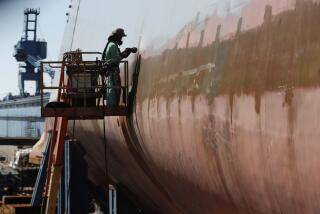$500-Million Simulator Proposed : On Paper, It Looks Like Battle-Ready Aircraft Carrier
- Share via
The scene might be borrowed from the movie “Top Gun.”
An aircraft carrier deck rocks from side to side as if in heavy seas, and a stream of hissing, whining F-14s are launched into the air. Other fighters appear out of the sky and bounce hard on the deck, coming to an abrupt, screeching halt.
But there is something unreal about this carrier. Its 1,000-foot deck rotates and moves up and down, but does not move forward or backward. The pitch-and-roll motion of the deck is created by hydraulics and the big ship turns 360 degrees on railroad tracks. This carrier sits on land, not water.
The scene, as described by two Costa Mesa businessmen, could be on San Clemente Island off San Diego or on Smith Island near Seattle. The year could be 1990.
This aircraft carrier, which exists only on paper, belongs to John Cole, a retired Army colonel, and William Heath, an engineer. The two men, who own Costa Mesa-based Cole Heath Co., have patented what they call the Navy Carrier Battle Simulator and Landing Deck, or NCBSLD. If the idea ever is adopted by the military--and the men have no commitments thus far--the company will collect royalties for the concept.
$500-Million Cost
Cole and Heath estimate that their practice carrier could be built for about $500 million, which could include up to 12 decks used to store aircraft and house, feed and train thousands of sailors at a time, including deck crews, fire crews, air-traffic controllers and even officers who pilot the huge carriers. Cole and Heath believe the Navy might need up to five practice carriers--two on the East Coast, two on the West Coast and one in the Gulf of Mexico. It could take three years to design and build one of the carriers that, once built, could be put on government-owned islands or on offshore platforms.
“It is an idea whose time is here,” said Cole, pointing to the increasing jet noise produced by training flights at military airstrips.
Cole and Heath said jet noise at places such as Miramar Naval Air Station, El Toro Marine Corps Air Station and Whidbey Island Naval Air Station near Seattle could be reduced substantially by removing carrier training exercises to offshore landing decks. Removal of the practice flights from populated areas would also reduce the dangers to civilians in a crash, Cole said.
Real Experience
Cole added that Marine and Navy pilots could perform actual carrier landings and takeoffs, rather than just swooping their fighters down on a predesignated spot on a land-based runway, touching the wheels to the asphalt and taking off again.
Simply, the idea calls for building a full-scale flight deck such as the one on the Nimitz, the largest carrier deployed by the Navy. The 1,092-foot deck for landing and launching Navy and Marine jets would sit on hydraulic devices that could, through computers, create pitch-and-roll motions identical to an aircraft carrier’s at sea. The degree of movement could simulate either rough seas or good weather.
Information about the stationary aircraft carriers has been sent to the Navy, the Marines and the Department of Defense.
“The response we get every time was the same response the naval planner told me yesterday when he called me to talk to me about this: ‘Why didn’t someone think of this before?’ ” Cole said recently.
Maj. Gen. D. E. P. Miller, commander of the Third Aircraft Wing at El Toro, called the concept a “great idea” if the device could reduce aircraft noise in neighborhoods near air bases and at the same time provide carrier training for his pilots more realistic than they get on land.
Practicing nighttime carrier landings at the base, Miller said, is far from realistic because of lights from the surrounding community and freeways. Even though they try not to, the pilots use these lights as reference points to turn in the darkness. When they go out to sea, those lights, of course, are not there--”It’s as black as the inside of a stovepipe,” Miller said.
The commander of the Pacific Fleet’s naval air force, Vice Adm. John H. Fetterman Jr., said through a spokesman that pilot training ashore was very important and could not be eliminated. Fetterman had received a copy of the Cole-Heath proposal.
But Cmdr. Ron Wildermuth, a spokesman for Fetterman, said the military should encourage anything that could reduce aircraft noise around military air stations.
Other Navy officials, who asked not to be identified, said Navy pilots must first learn carrier landings ashore to give them some “room for error” before trying them at sea.
“So there is no way to eliminate the beginning training ashore,” the officer said, adding that the cost of stationary training decks such as those proposed by Cole-Heath might be prohibitive.
But Cole said stationary training decks on islands or on offshore platforms would save money in the long run by not using multibillion-dollar carriers for training. He said the proposed training carriers could be used 24 hours a day for training for pilots, fire crews and deck crews.
More to Read
Sign up for Essential California
The most important California stories and recommendations in your inbox every morning.
You may occasionally receive promotional content from the Los Angeles Times.













